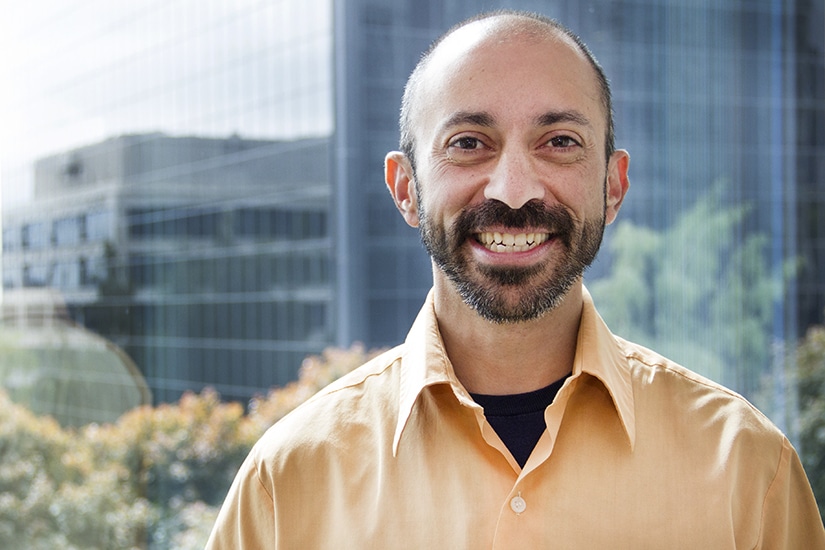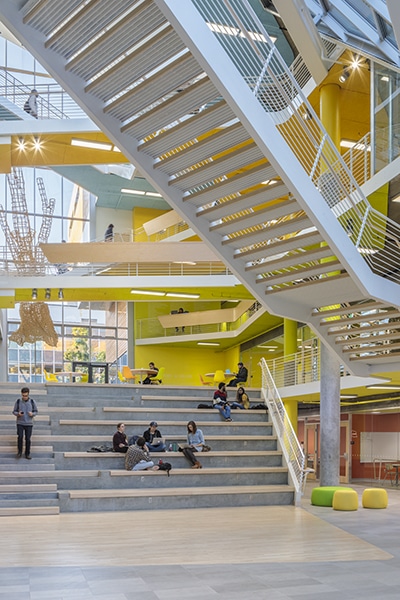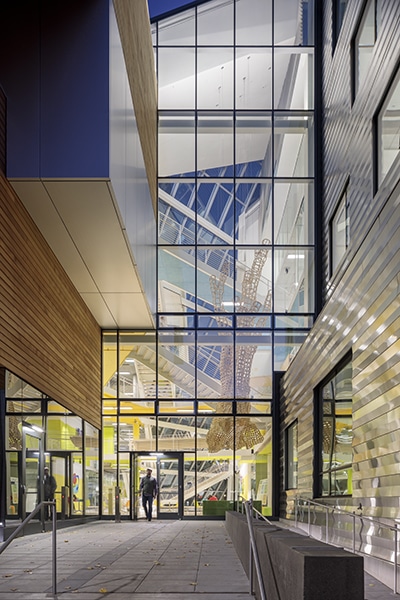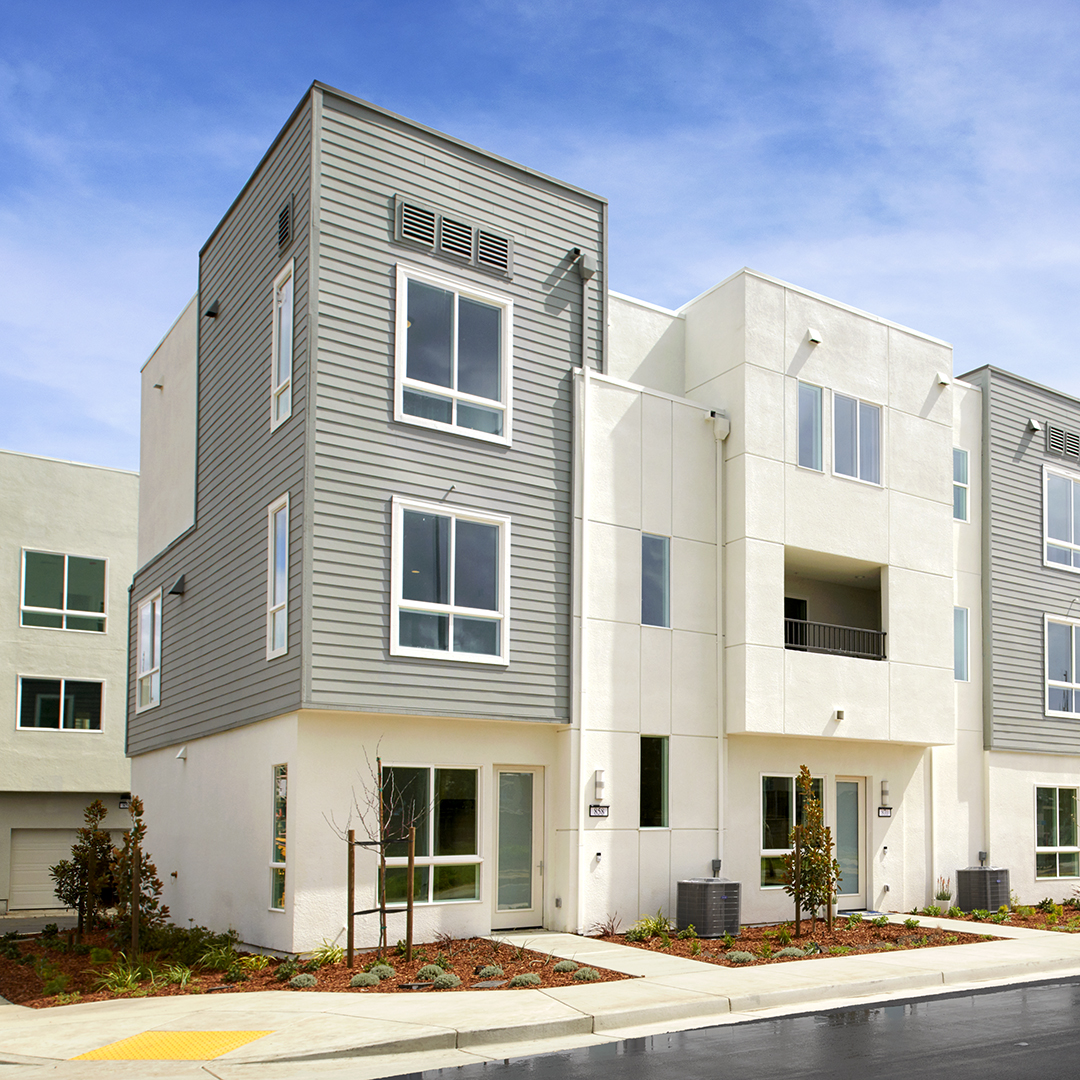|
Getting your Trinity Audio player ready...
|
College campuses are complex environments. They typically include multiple buildings that not only serve teaching, laboratory, administrative, and residential functions but are also all connected by energy, water, and transportation systems. So, it’s fair to say that these learning institutions are types of organisms. More specifically, they’re organisms functioning within ecosystems that feature adjoining neighborhoods, local culture, municipal jurisdiction, and regional economics.
Portland State University is one such organism—and a fairly robust one at that. It’s a 28,000-student institution with a 50-acre campus situated in the heart of Oregon’s largest city. Almost 90 percent of its students are commuters, and how they commute is an integral part of the green story of the university. This is not by accident: the school’s associate vice president of planning, construction, and real estate, Dan Zalkow, began his PSU career as assistant manager of transportation and parking services.

“Immediately after starting at PSU, I began taking graduate courses in transportation planning,” says Zalkow, who ultimately earned a master’s degree in urban and regional planning. “I found the field fascinating, especially as it related to land-use planning and the environmental benefits of commute modes other than driving alone.”
Those studies were spot-on for the job he has today: to Zalkow, it was all about the intersection of land use and transportation planning. Portland is an ideal city for making that happen, as it’s somewhat famous for its sustainability cred and culture. In fact, 42 percent of university employees and 50 percent of students take public transportation to the campus, while only 31 percent and 19 percent drive alone in a car, respectively. (Nationally, a whopping 76.4 percent of workers commute alone by car.) About 12 percent of employees and 5 percent of students commute by bike, while 5 percent and 18 percent walk. In 2013, the League of American Bicyclists awarded PSU with platinum status within the Bicycle Friendly University program, one of only five universities in the country presented with that honor.

But as every organism mutates, PSU has seen a two-thirds drop from 12 percent in 2010 to 4 percent in 2017 in students who bike. Why? Housing affordability near the campus is largely at fault, causing students to live farther away where biking is less practical. According to the Census ACS survey, the city’s median gross rent climbed almost 20 percent between 2014 and 2017, compared to about 6 percent nationwide. Clint Culpepper, PSU transportation options manager, adds that the increasing vehicular traffic that accompanies increasing population is also likely responsible for fewer bikers.
Transit use appears to have compensated for the drop in biking, not unlike a healthy kidney making up for a weaker one. This speaks to the culture of green transportation by any means—as well as the school’s fortunate position within a city grid that features buses, streetcars, a light rail and commuter rail, and even an aerial tram.
The PSU campus and the buildings within its orbit are equally green, earning enviable certifications and ratings. As early adopters of the LEED program, the school has 15 buildings with the certification, including four new structures achieving Silver and Gold in the operations and management category—which focuses on existing buildings—since 2017.
Adding a noteworthy new building that’s set to open in 2020 speaks not only to PSU’s sustainability ethos but also to its place in the broader Portland community and infrastructure. Known simply as the Fourth and Montgomery Building, the seven-story, 175,000-square-foot structure will house four entities in a commercial condominium: Portland Community College, Oregon Health Sciences University, the Bureau of Planning and Sustainability, and PSU’s College of Education.

The $104 million building will also feature ground-level retail, a bike garage—complementing 10 other bike garages elsewhere on campus and a 2,500-square-foot bike shop—and a “bird-safe” exterior glazing that covers 40 percent of exterior walls and provides important natural lighting in the interior. Emergency stairwells are designed with glass walls to encourage occupant use in lieu of elevators. With an eco-roof, solar panels, and overall high-energy efficiency features (e.g., R-21 insulation), the university is on track to achieve LEED Gold certification.
Jennifer McNamara, PSU’s campus sustainability director, reports several other accolades achieved, including six years as a STARS Gold-rated university (sustainability tracking, assessment, and rating system), ranking 31st out of 953 participating institutions, and a top-50 ranking in the Sierra Club Cool Schools index. PSU’s Faculty Fellows of the Institute for Sustainable Solutions program, a cross-departmental network of 140 faculty members from different disciplines and expertise, supports research, shared knowledge, and financial support to interdisciplinary research teams.
Zalkow adds that the school exceeds design requirements of the Americans with Disabilities Act, instead using the more comprehensive Universal Design principals as a guide.

“I don’t consider any ADA requirements as stringent,” says Zalkow. “There are a lot of ways to exceed the mandates with just good design. It helps us with faculty and student recruitment and retention, and it’s in greater alignment with how teaching and research will be done in the future.”
In other words, this is an organism in an ecosystem that is built to be sustainable.
Founded in 1989 and working out of offices in Stuttgart, Munich, and Boston, Behnisch Architekten recently collaborated with Dan Zalkow and his team to complete the award-winning Karl Miller Center. Dan’s leadership was instrumental in fostering a collaborative team culture that harnessed the team’s strengths and collective wisdom.


